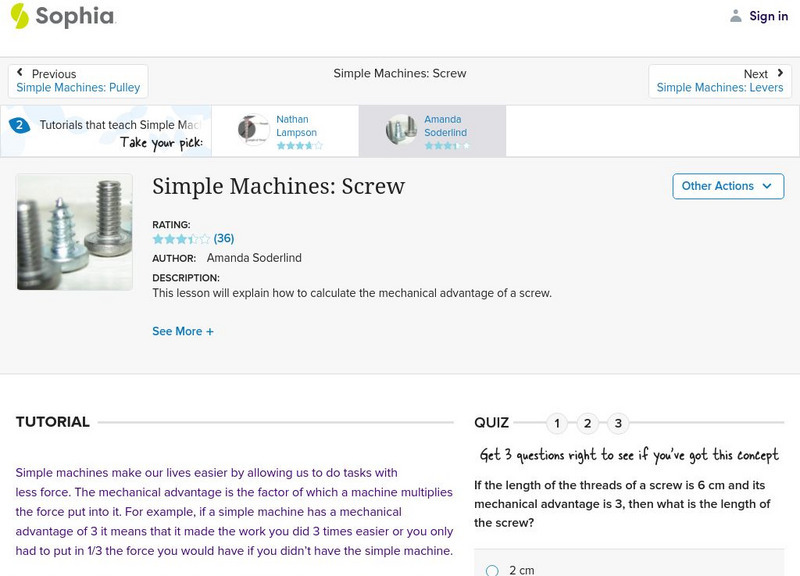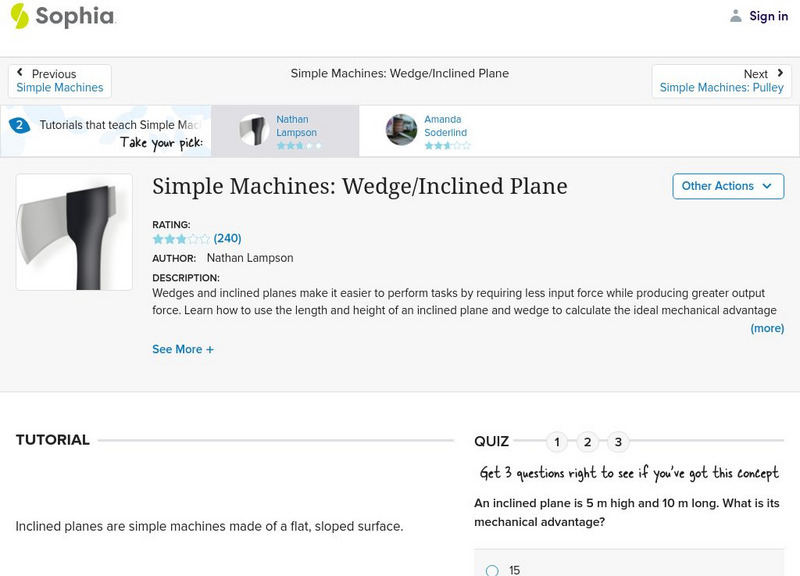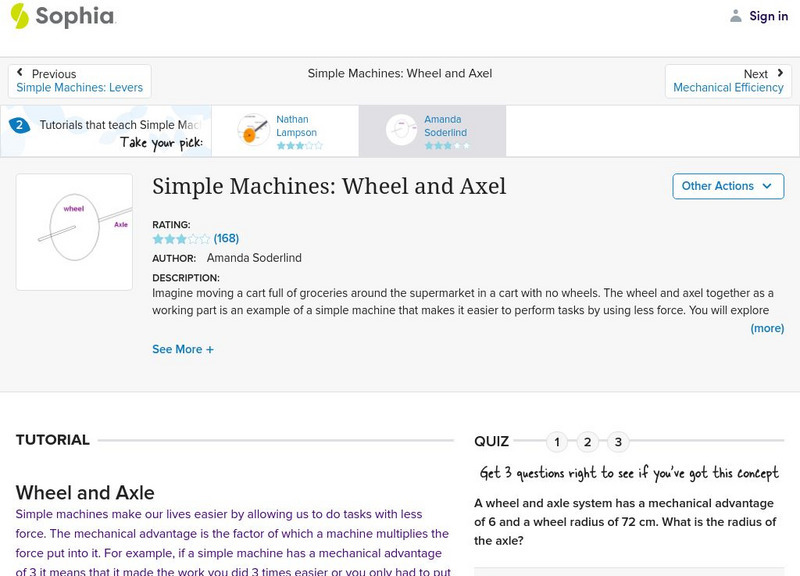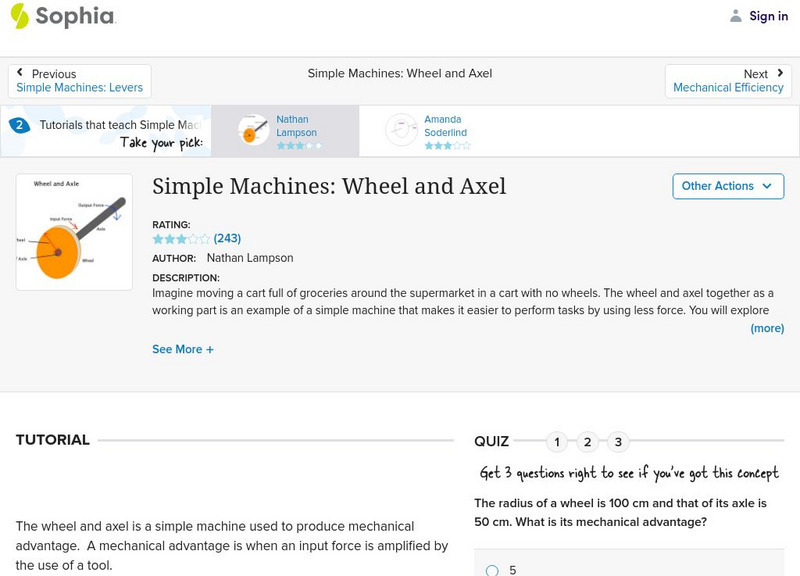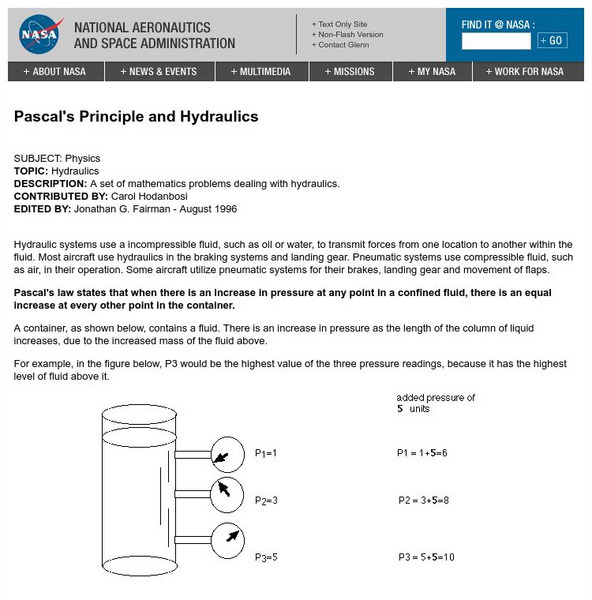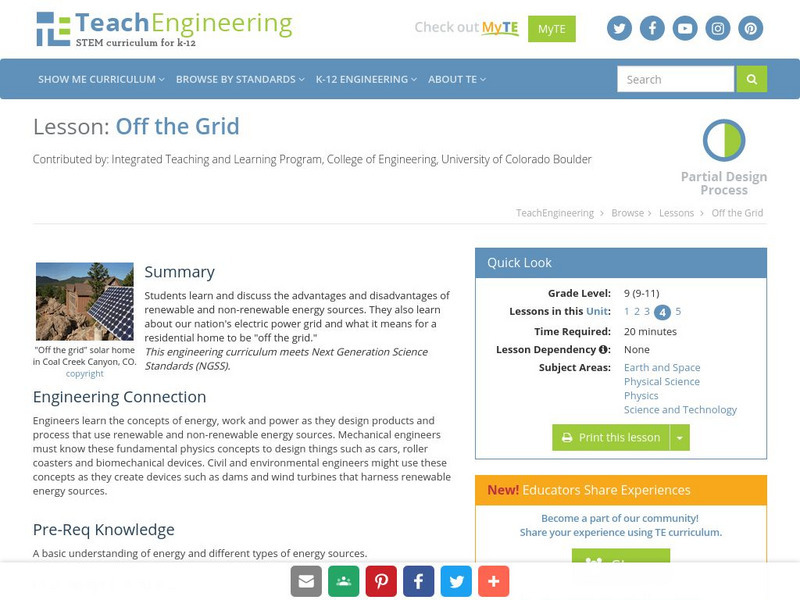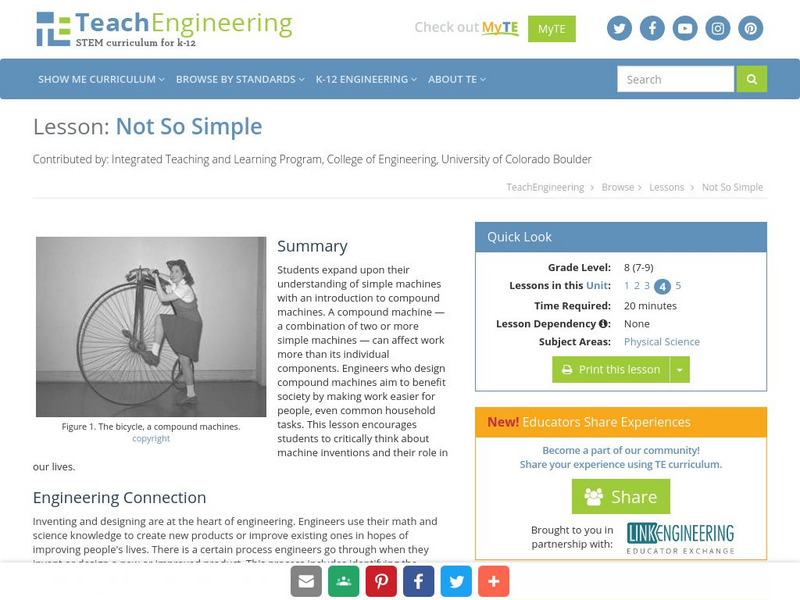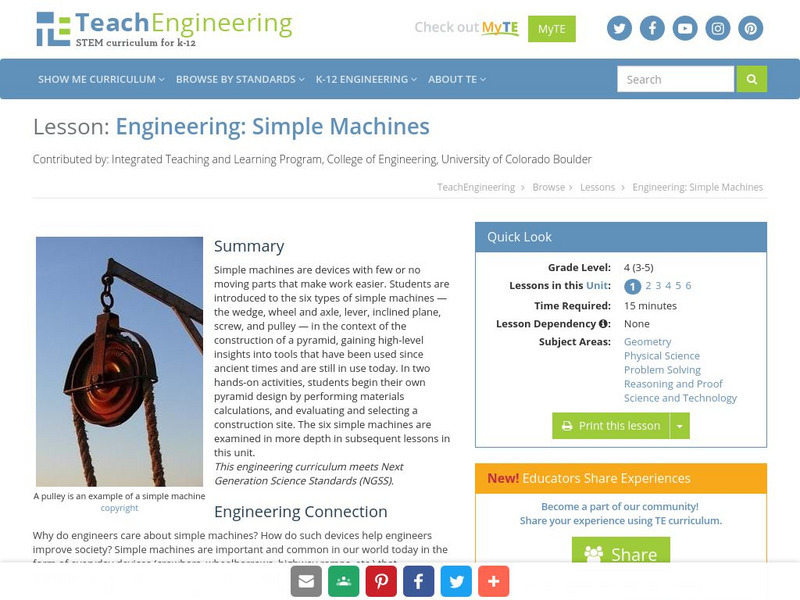Sophia Learning
Sophia: Simple Machines: Screw: Lesson 1
This lesson will explain how to calculate the mechanical advantage of a screw. It is 1 of 2 in the series titled "Simple Machines: Screw."
Sophia Learning
Sophia: Simple Machines: Wedge/inclined Plane: Lesson 2
This lesson will explain how to calculate the mechanical advantage of a wedge and inclined plane. It is 2 of 2 in the series titled "Simple Machines: Wedge/Inclined Plane."
Sophia Learning
Sophia: Simple Machines: Wedge/inclined Plane: Lesson 1
This lesson will explain how to calculate the mechanical advantage of a wedge and inclined plane. It is 1 of 2 in the series titled "Simple Machines: Wedge/Inclined Plane."
Sophia Learning
Sophia: Simple Machines: Wheel and Axel: Lesson 1
This lesson will explain how to calculate the mechanical advantage of a wheel and axel. It is 1 of 2 in the series titled "Simple Machines: Wheel and Axel."
Sophia Learning
Sophia: Simple Machines: Wheel and Axel: Lesson 2
This lesson will explain how to calculate the mechanical advantage of a wheel and axel. It is 2 of 2 in the series titled "Simple Machines: Wheel and Axel."
Integrated Publishing
Integrated Publishing: The Wheel & Axle
A solid chapter explanation of the wheel & axle simple machine. Examples, the basic math, explanation of mechanical advantage, drawings, solved problem. Use the Next button. There are four pages in this chapter.
Technovation
Curiosity Machine: Challenges: Construct a Crane
Can you build a crane that uses simple machines and mechanical advantage to move heavy objects? This website contains a challenge, tips, a lesson plan, and a place for students to document their engineering design process.
NASA
Nasa: Pascal's Principle and Hydraulics
Pascals Principle is explained, illustrated, and related to hydraulics. Learning exercises are given and answered at this NASA site.
TeachEngineering
Teach Engineering: Let's Move It!
Students explore methods employing simple machines likely used in ancient pyramid building, as well as common modern-day material transportation. They learn about the wheel and axle as a means to transport materials from rock quarry to...
TeachEngineering
Teach Engineering: Off the Grid
Learners learn and discuss the advantages and disadvantages of renewable and non-renewable energy sources. They also learn about our nation's electric power grid and what it means for a residential home to be "off the grid."
Science Struck
Science Struck: Piston Pump vs. Diaphragm Pump
Learn the difference between a piston pump and a diaphragm pump, both of which are positive displacement pumps. Includes chart listing characteristics for each, their different types, and their advantages and disadvantages.
TeachEngineering
Teach Engineering: Simple Machines and Modern Day Engineering Analogies
Students apply the mechanical advantages and problem-solving capabilities of six types of simple machines (wedge, wheel and axle, lever, inclined plane, screw, pulley) as they discuss modern structures in the spirit of the engineers and...
CK-12 Foundation
Ck 12: Physical Science: Pulley
[Free Registration/Login may be required to access all resource tools.] What a pulley is and the three basic types, and the mechanical advantage of a pulley.
Integrated Publishing
Integrated Publishing: Levers
A quite lengthy chapter on the simple machine the lever. Includes uses, classes, mechanical advantage, formulae, etc. A full discussion, with good illustrations.
TeachEngineering
Teach Engineering: Not So Simple
Middle schoolers expand upon their understanding of simple machines with an introduction to compound machines. A compound machine - a combination of two or more simple machines - can affect work more than its individual components....
CK-12 Foundation
Ck 12 Exploration Series: Simulations: Physics: Ramp and Piano
[Free Registration/Login Required] This module has students using a simple machine to learn about the relationship between work, force, and energy.
Science Buddies
Science Buddies: Give It a Lift With a Lever
Simple machines allow us to do difficult tasks like lifting objects heavier than our body weight. In this science project you'll build a tabletop lever and measure how much effort it takes to lift an object by altering the length of the...
OpenStax
Open Stax: Forces and Torques in Muscles and Joints
From a chapter on Statics and Torque in a Physics textbook. This section of the chapter provides an in-depth discussion of forces and torque in the human body. We learn about muscular force, the importance of posture in preventing back...
PBS
Pbs Teachers: Secrets of Lost Empires I Colosseum
Discover how to use pulleys to change the direction of force, compare different pulley designs and discuss the advantages and disadvantages of a pulley.
Scholastic
Scholastic: Dirtmeister's Science Reporters: The Lever
This site provides a description of the lever and its many uses.
TeachEngineering
Teach Engineering: Solid Rock to Building Block
Students continue their pyramid building journey, acting as engineers to determine the appropriate wedge tool to best extract rock from a quarry and cut into pyramid blocks. Using sample materials (wax, soap, clay, foam) representing...
TeachEngineering
Teach Engineering: Engineering: Simple Machines
Simple machines are devices with few or no moving parts that make work easier. Students are introduced to the six types of simple machines - the wedge, wheel and axle, lever, inclined plane, screw, and pulley - in the context of the...
TeachEngineering
Teach Engineering: Pyramid Building: How to Use a Wedge
Young scholars learn how simple machines, including wedges, were used in building both ancient pyramids and present-day skyscrapers. In a hands-on activity, students test a variety of wedges on different materials (wax, soap, clay,...
TeachEngineering
Teach Engineering: Slide Right on by Using an Inclined Plane
Students explore building a pyramid, learning about the simple machine called an inclined plane. They also learn about another simple machine, the screw, and how it is used as a lifting or fastening device. During a hands-on activity,...
Other popular searches
- Ideal Mechanical Advantage
- Levers Mechanical Advantage
- Ramp Mechanical Advantage
- Mechanical Advantage Pulley
